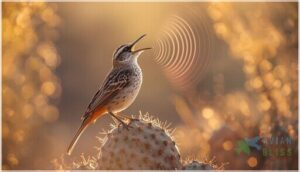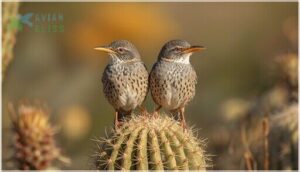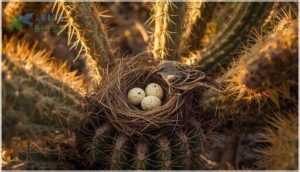This site is supported by our readers. We may earn a commission, at no cost to you, if you purchase through links.

The curve-billed thrasher doesn’t just survive in the harsh Sonoran Desert—it thrives there. While most birds avoid the unforgiving heat and spiny vegetation, this scrappy desert dweller has made chollas and thorny mesquite its fortress.
You’ll often spot one perched atop a saguaro at dawn, belting out a song so complex it rivals the mockingbird’s repertoire. Its namesake curved bill isn’t just for show—it’s a precision tool designed to flip rocks, probe bark, and extract insects from places other birds can’t reach.
With striking orange eyes and a spotted belly, this thrasher has carved out a niche where few competitors dare to venture, becoming a symbol of desert resilience and adaptability.
Table Of Contents
- Key Takeaways
- Identifying The Curve-billed Thrasher
- Habitat and Geographic Range
- Behavior and Social Structure
- Nesting and Reproduction
- Conservation Status and Ongoing Efforts
- Frequently Asked Questions (FAQs)
- What is a curve-billed thrasher?
- What is the difference between curve-billed and crissal thrashers?
- How to attract curved bill thrasher?
- What is the difference between curve-billed and Bendiere’s thrasher?
- How do Curve-billed Thrashers communicate?
- What threats face Curve-billed Thrashers today?
- Are Curve-billed Thrashers migratory birds?
- How intelligent are Curve-billed Thrashers?
- Do Curve-billed Thrashers have any predators?
- What does the Curve-billed Thrashers song sound like?
- Conclusion
Key Takeaways
- The curve-billed thrasher’s signature curved bill functions as a specialized foraging tool that lets it flip rocks, probe bark, and extract insects from places other desert birds can’t access, giving it a survival advantage in the harsh Sonoran Desert.
- This species shows zero sexual dimorphism—males and females are completely identical in size, plumage, and bill shape, making field identification between sexes impossible without genetic testing.
- Population data reveals a 14% decline between 1966 and 2015 across North America, with habitat fragmentation and climate change threatening 31% of their range with lethal dehydration despite their current “Least Concern” conservation status.
- Curve-billed thrashers build nests exclusively in thorny vegetation like cholla cacti for natural predator protection, yet still face harsh reproductive realities with only 37-44% fledging success due to snake predation accounting for nearly one-third of all nest failures.
Identifying The Curve-billed Thrasher
You’ll know a Curve-billed Thrasher when you see one if you focus on a few key traits. This bird has physical features and behaviors that set it apart from other thrashers in its range.
Let’s break down what to look for in the field.
Distinctive Physical Features
You’ll recognize the Curve-billed Thrasher (Toxostoma curvirostre) by its signature sickle-shaped bill—strongly decurved and measuring 21 to 32 mm depending on subspecies. This member of Mimidae showcases grayish-brown plumage with faint round spotting across the breast. Adults display striking orange to golden eye color, while juveniles show duller yellow-brown irises.
Key identification markers include:
- Bill shape: Nearly as long as head width with brownish-black curvature
- Feather patterns: Pale throat contrasting with spotted belly and orangey undertail coverts
- Plumage texture: Sturdy body measuring 27–28 cm with broad wings and wedge-shaped tail
The Curve-billed Thrasher is often found in desert shrub habitats, which provide ideal conditions for its survival.
Comparison With Similar Species
When you’re sorting out desert bird species, the Curve-billed Thrasher stands apart from its cousins through subtle but telling details. Bill shape matters most—Bendire’s Thrasher sports a straighter, shorter beak (6–11 mm difference in beak length), while California Thrashers show dark eyes versus the Curve-billed Thrasher’s yellow-orange iris.
Plumage color also helps: Long-billed Thrashers display heavy black streaking, not the rounded spots you’ll find on your target avian species. The Curve-billed Thrasher’s identification can be confirmed by examining its bird physical characteristics to distinguish it from similar species.
Vocalizations and Mimicry Abilities
Beyond field marks, you’ll hear this thrasher before spotting it. The “whit-wheet” call—sharp and double-noted—announces Toxostoma curvirostre’s presence in desert acoustics from dawn to dusk.
Song complexity varies wildly; individuals rarely repeat the same melodic sequence twice. Mimicry patterns exist but stay subtle compared to mockingbirds.
Call variations include warbles, buzzes, and occasional borrowed phrases from neighboring species—vocal learning that reflects avian ecology shaped by open brushland territories.
Dimorphism Between Males and Females
Unlike many bird species overview studies, you won’t find sexual dimorphism here. Sexual monomorphism defines Toxostoma curvirostre—both sexes share identical plumage patterns, biometric measurements, and that signature curved bill. Morphometric studies confirm what field observers know: males and females are indistinguishable without genetic insights or internal examination.
- Both sexes measure 9.5–11.5 inches with identical golden-orange eyes
- Weight ranges from 2.0–3.3 ounces regardless of sex
- Plumage patterns show no variation between males and females
- Biometric analysis of 800+ specimens found zero measurable differences
- Behavioral roles in territory defense remain interchangeable
This sexual monomorphism challenges traditional bird identification methods in avian ecology and ornithology research.
Habitat and Geographic Range
You’ll find curve-billed thrashers where the desert meets dense, thorny scrub—a landscape that might seem harsh but offers everything these birds need to thrive. Their range stretches across the American Southwest and into Mexico, following the patchwork of cactus forests and mesquite-studded valleys.
Let’s look at where these birds make their home and how they’re adapting to a changing landscape.
Preferred Desert and Brushland Environments
You’ll find Curve-billed Thrashers thriving in semi-arid environments where cholla cactus and thorny vegetation dominate the landscape. These desert birds select brushland dynamics with dense shrub cover—usually 350 shrubs per hectare—and multiple vegetation layers. Cactus habitats with cholla densities exceeding 50 plants per hectare show the highest occupancy rates.
This ornithology research reveals how desert ecology shapes wildlife habitat preservation across the American Southwest’s diverse semi-arid environments.
Distribution in The American Southwest and Mexico
You’ll encounter the Curvebilled Thrasher across the American Southwest and Northern Mexico—from Arizona’s Sonoran Desert through New Mexico to west Texas. Desert Migration remains minimal since this species maintains year-round residency.
Regional Variance in population density reflects Climate Adaptation tied to Geographic Barriers like the Sierra Madre.
Border Ecology reveals highest concentrations where cholla cactus thrives, supporting Desert Wildlife Conservation efforts across diverse elevations spanning sea level to 3,000 meters.
Adaptation to Urban and Suburban Areas
Since the early 2000s, you’ll spot Curvebilled Thrashers in cities like Tucson and Phoenix—they’re the most common desert-adapted thrasher in Southwest urban habitats. Suburban Nesting thrives in cholla-dotted yards where these birds show exceptional Urban Habitat Use.
Human Thrasher Interaction stays minimal; they visit feeders within ten minutes while maintaining stable Thrasher Migration Patterns—year-round residency. Urban Food Sources and native landscaping support 3.1 million individuals citywide, advancing Desert Wildlife Conservation through bird watching efforts.
Impact of Habitat Loss on Populations
You’re watching a species lose ground fast. Habitat Fragmentation drove Curve-billed Thrasher populations down 14% between 1966 and 2015 across North America. Desert Ecosystems in Arizona and Texas face the sharpest population decline as development carves up wildlife habitat.
This Biodiversity Loss threatens ecology and bird behavior patterns. Conservation Strategies now focus on protecting continuous shrubland corridors for wildlife conservation.
Behavior and Social Structure
You’ll notice the curve-billed thrasher lives life on its own terms. This bird doesn’t follow the typical songbird playbook when it comes to finding food or defending its space.
Let’s break down how these desert survivors handle daily life, from their bold foraging moves to the way they interact with neighbors.
Foraging Techniques and Diet
You’ll notice the Curve-billed Thrasher’s bill sweeping technique when it forages on open ground. The bird uses side-to-side movements to clear debris and dig shallow holes. Diet includes grasshoppers, beetles, and caterpillars during breeding season.
Urban diets show feeding behavior shifts as thrashers visit feeders regularly. Seasonal variation affects prey capture rates. Summer brings increased fruit consumption.
These birds aid seed dispersal while supporting avian feeding behavior studies in desert ecology.
Territorial Behavior and Defense
You’ll witness fierce defense mechanisms when curve-billed thrashers protect their lifelong territories. Males sing from perches to mark boundaries, sometimes spanning several acres. Urban territories show stronger avian behavior patterns in desert-like vegetation, though testosterone levels don’t drive this shift.
- Aggressive vocal displays warn intruders year-round
- Rapid dashes between cover spots during confrontations
- Resource competition intensifies in breeding season
- Wildlife behavior studies reveal habitat features influence territorial intensity
- Bird watching tips: observe perimeter singing at dawn for best wildlife conservation efforts documentation
Mating Habits and Pair Bonding
Beyond territorial defense, curve-billed thrashers commit to lifelong partners. Mate selection involves brief chases and countersinging, culminating in monogamous bonds that span years. Pair formation typically starts in early February, with both sexes cooperating in nest construction.
Bird nesting habits reveal high success rates—fertility reaches 94% in ideal conditions. This devotion to breeding and nesting behavior sets them apart in ornithological research on ecological habitats.
| Pair Bond Feature | Observed Pattern |
|---|---|
| Territory Duration | 5-11 acres, year-round |
| Breeding Attempts | 2 broods per season |
| Clutch Size | 2-3 eggs usually |
Interactions With Other Bird Species
While paired bonds endure, curve-billed thrashers don’t shy from confrontation. Agonistic Behavior defines their interactions—you’ll see them lock bills mid-air with rivals. Territorial Disputes erupt over nesting competition, especially with Cactus Wrens. Interspecies Communication includes harsh alarm calls and occasional mimicry. Their Flocking Patterns? They forage solo or paired, avoiding mixed-species groups entirely.
- Aerial combat with competing thrashers
- Destroying Cactus Wren roost-nests within territories
- Chasing Brown-headed Cowbirds from nest vicinities
- Dominating smaller doves at backyard feeding stations
Nesting and Reproduction
You’ll find curve-billed thrashers building their nests in some pretty unforgiving spots—think thorny cacti and dense mesquite thickets where most birds wouldn’t dare. These desert survivors have turned spiny vegetation into their fortress, raising young in places that offer natural protection from predators.
Let’s break down how they construct their nests, care for their chicks, and defend against threats.
Nest Construction and Preferred Locations
You’ll find Curve-billed Thrashers constructing their cup-shaped nests from thorny twigs and grass, often tucked 3 to 5 feet high in desert shrubs like cholla or mesquite. Their nest architecture resembles what Cactus Wrens build, though thrashers prefer denser vegetation.
Both sexes weave nesting materials over days or weeks, creating bulky structures about 9 inches wide. These nesting habits reflect smart habitat distribution choices—thorny plants deter predators before incubation begins.
Egg-laying and Incubation
Once the nest is ready, you’ll see females laying 2 to 5 eggs between late February and July, with May being peak season. Incubation lasts 12 to 15 days, performed mainly by females while males defend territory. Brood survival faces serious challenges—snakes are the main threat, though nesting success hits 37% overall.
Consider these reproductive cycles:
- Clutch sizes average 3 to 4 eggs in typical conditions
- Extreme heat above 36°C disrupts incubation periods
- Egg laying patterns shift with seasonal rainfall fluctuations
- Replacement broods occur after predation events
Parental Care and Chick Development
During the first two weeks after hatching, both parents bring food every 10 minutes, while the female shields the chicks from the scorching heat. Brood reduction occurs when parents favor the strongest nestlings during scarce conditions. Fledging success reaches only 37-44% due to sibling competition and predation.
| Parental Role | Key Behavior |
|---|---|
| Female | Shading and brooding young |
| Male | Territory defense and provisioning |
| Both Parents | Feeding every 10 minutes |
Nest Predators and Defense Strategies
You’ll face a fierce opponent in the snake, which accounts for 32.6% of documented nest raids on Curve-billed Thrasher broods. Brood protection intensifies when chicks hatch, with both parents attacking intruders. Their defensive behaviors include:
- Building nests in cholla cacti for natural predator deterrents
- Maintaining 87.5% vegetative cover for nest camouflage
- Launching aerial attacks against raptors and crows
- Destroying competitor nests to reduce local predation pressure
These nesting adaptations reflect essential wildlife conservation efforts in avian ecology.
Conservation Status and Ongoing Efforts
You might think a bird this tough would thrive anywhere, but the Curve-billed Thrasher faces real challenges across its range.
Population numbers tell an important story about how human activity shapes the destiny of desert wildlife.
Let’s look at where things stand and what’s being done to keep these birds singing in the Southwest.
Current Population Trends and Estimates
You’ll find that the Curve-billed Thrasher isn’t backing down anytime soon. Global estimates hover around 3.1 million individuals, with Partners in Flight reporting 3.4 million.
Regional trends show slight population declines in Texas, but species abundance remains strong westward.
The bird’s conservation outlook stays optimistic—it’s classified as Least Concern, proving its resilience across the Southwest’s shifting landscapes.
Major Threats to Survival
You’re watching a resilient species face mounting pressure. Habitat fragmentation and climate change are rewriting survival rules—31% of the thrasher’s range already risks lethal dehydration. Human disturbance elevates stress and disrupts breeding.
Habitat loss and climate extremes now threaten 31% of the Curve-billed Thrasher’s range with lethal dehydration
Nest predation claims 80% of attempts annually. Resource depletion intensifies competition.
Wildlife conservation and ecological conservation efforts targeting nature conservation must address these interconnected threats before wildlife conservation and research lose ground.
Conservation Programs and Protected Areas
You’ll find protection across six critical ecoregions, where wildlife refuges and protected areas form a safety net for thrashers. Habitat restoration targets cholla cactus densities above 50 plants per hectare—your best bet for occupancy success.
Conservation efforts span Texas, Arizona, and Kansas through ecoregion management programs. Wildlife conservation and research teams maintain thousands of acres via land trusts, implementing ecological conservation efforts that address nature preservation while managing invasive species and urban sprawl.
Citizen Science and Monitoring Initiatives
You can join volunteer training programs across Arizona and Texas that teach data collection through point counts and transect research methods.
Project FeederWatch and similar ornithology initiatives let you track bird distribution and habitat patterns while supporting ecological conservation efforts.
Your observations feed into databases that measure conservation impact through community engagement, helping scientists understand population trends and guide conservation efforts for this declining species.
Frequently Asked Questions (FAQs)
What is a curve-billed thrasher?
You’ll spot this masterful desert survivor by its wickedly curved bill—a brownish-gray songbird measuring around 11 inches.
This avian species thrives throughout southwestern brushlands, showcasing exceptional desert adaptation through specialized foraging techniques and territorial intelligence.
What is the difference between curve-billed and crissal thrashers?
You can spot the difference in bill shape and plumage color. Curve-billed Thrashers have shorter, thicker bills and spotted breasts. Crissal Thrashers show longer, thinner bills with chestnut undertail coverts and bolder plumage patterns.
How to attract curved bill thrasher?
You can attract the Cuitlacoche Piquicurvo by planting thorny shrubs and native plants like cholla cactus in your garden.
Add bird feeders with mealworms, provide shallow water sources, and leave nesting materials in semiopen areas.
What is the difference between curve-billed and Bendiere’s thrasher?
Like two cousins sharing the same desert, these thrashers differ in bill shape and facial markings. Curve-billed sports a longer, more curved bill and uniform face, while Bendire’s shows a straighter bill with pale facial patterns for species distinction.
How do Curve-billed Thrashers communicate?
You’ll hear Curve-billed Thrashers use territorial calls year-round and complex songs lasting 2-15 seconds. They mimic Scissor-tailed Flycatchers and Northern Cardinals while maintaining lifelong pair bonds through coordinated vocal exchanges.
What threats face Curve-billed Thrashers today?
You’ll find habitat loss from urban sprawl and agriculture hitting hardest. Climate change brings dangerous heat and dehydration risks. Nest predation stays high. Human disturbance and desert fragmentation keep chipping away at survival.
Are Curve-billed Thrashers migratory birds?
No. These bird species show resident behavior year-round. You won’t see seasonal movement or true species migration. Vagrancy records and juvenile dispersal events explain rare appearances outside their normal range.
How intelligent are Curve-billed Thrashers?
Sharp minds shine through in Passeriformes: these thrashers excel at vocal learning, foraging innovation, and spatial memory.
You’ll notice their adaptability in ornithology studies—they recognize neighbors, defend territories, and even mimic other bird species.
Do Curve-billed Thrashers have any predators?
Yes, you’ll encounter several threats in their world. Snake predation dominates nest losses, while avian threats like ravens and roadrunners hunt eggs and young.
Their survival strategies include nest defense and predator avoidance through thorny plant selection.
What does the Curve-billed Thrashers song sound like?
You’ll hear a sharp “whit-wheet” whistle from elevated perches. Song structure includes short staccato phrases lasting 2-15 seconds. Eastern populations show mimicry patterns, imitating species like pyrrhuloxia and scissor-tailed flycatcher.
Conclusion
Like the phoenix rising from desert ash, the curve-billed thrasher endures where others falter. You’ve seen how its curved bill unlocks survival secrets. You’ve traced its song across cholla forests. You’ve watched it defend territory with fearless resolve.
Now you understand why this bird doesn’t just occupy the Sonoran Desert—it owns it. Its future depends on protecting the thorny wilderness it calls home. That responsibility starts with you.











